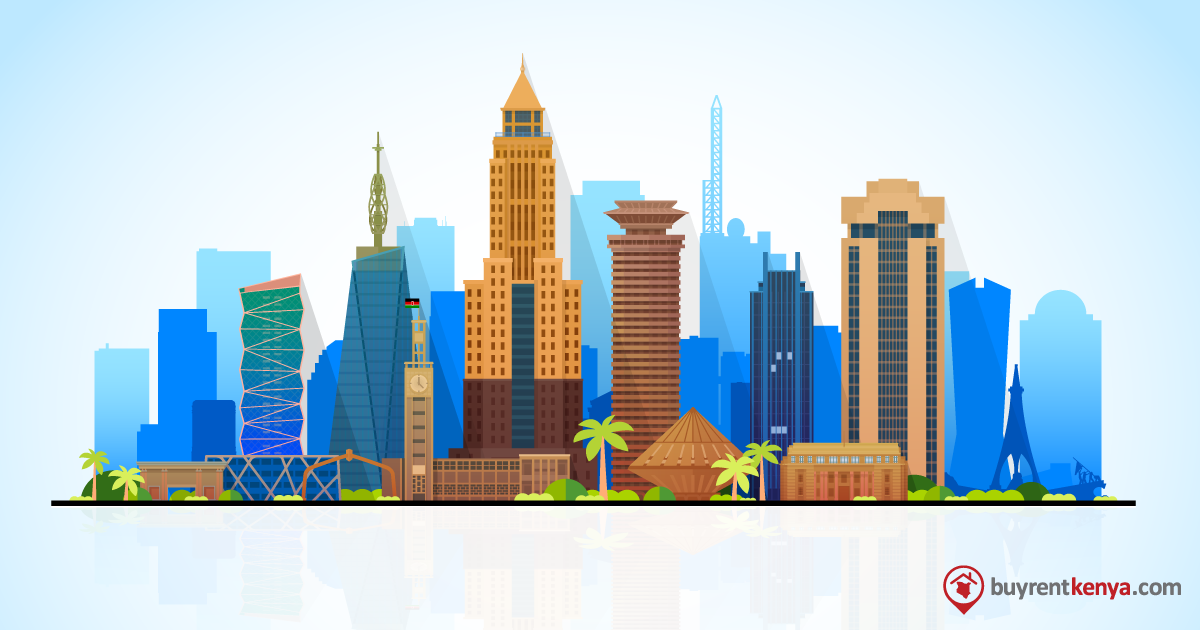Welcome to the captivating world of Kenya’s urban architecture, where buildings reach for the sky, and the cityscape boasts an array of impressive skyscrapers. In this blog, we will be exploring the tallest buildings in Kenya, marveling at their architectural prowess, and uncovering the historical context behind their construction.
As Kenya’s economy and urban centers have experienced tremendous growth, these soaring structures have become iconic symbols of progress and modernity. From Nairobi’s bustling skyline to other urban hubs, these skyscrapers stand as testaments to the nation’s ambition and drive.
Here are 5 of the tallest buildings in Kenya
Table of Contents
Britam Towers
Rising 200 meters tall in Nairobi’s Upper Hill, Britam Tower is an office complex with a striking prismatic design. It opened to the public in July 2018, snatching the title of Kenya’s tallest building from UAP Old Mutual Tower.
Its black pyramid shape with a missing corner captivates from one angle, while revealing a slender black prism from others. Notably, Britam Tower made history as the first African building to be ranked in the Emporis Skyscrapers Award’s top ten, securing its place as a global architectural marvel and an iconic symbol of Nairobi’s modernity.
Nairobi GTC Towers
The Nairobi GTC Office Tower, a prominent addition to Kenya’s skyline, stands tall as the tallest of the six towers comprising the impressive Sh40 billion Global Trade Centre. Soaring to a height of 184 meters with 43 floors, this towering office block serves as the African headquarters for Avic, a prominent Chinese firm.
GTC sits on a vast 7.5-acre land in the Westlands area of Nairobi to establish its continental hub. After an extensive construction period starting from July 2015, the grand opening of this remarkable tower finally took place in December 2021, marking a significant milestone in Nairobi’s architectural landscape. As the majestic Nairobi GTC Office Tower now graces the city’s skyline, it showcases Kenya’s thriving urban development and growing global significance.
READ ALSO: Property Evaluation Insights- Nairobi Office Space
UAP Old Mutual
The UAP Old Mutual Tower, a striking concrete structure, once proudly held the title of Kenya’s tallest building and the third tallest in Africa until Britam Tower’s rise in 2017. Nestled in the bustling Upper Hill area, this impressive 163-meter tower earned its place as Nairobi’s tallest when it opened in July 2016 after over five years of construction.
Boasting 33 floors and covering approximately 300,000 square feet, it offered premium Grade A office space in Nairobi’s rapidly expanding commercial district. At an impressive altitude of 5,700 feet above sea level, the UAP Old Mutual Tower stands tall as Nairobi’s highest point, surpassing Rahimtulla Tower, the previous record holder. A testament to the city’s evolving skyline and growth, this tower continues to be an iconic presence in Nairobi’s dynamic landscape.
Nairobi GTC Hotel Tower
The Nairobi GTC Hotel Tower, standing as the second tallest among the six towers of the Global Trade Centre, has made an impressive entry into the league of Kenya’s tallest skyscrapers. Reaching a height of 141 meters with 35 floors, this remarkable building is set to host the prestigious JW Marriott hotel, a star-studded addition operated by Marriott International.
Construction for the Nairobi GTC Hotel Tower commenced in July 2015, and with its completion this year, it has quickly become a significant landmark on Nairobi’s ever-evolving skyline. As visitors and guests step into the luxurious JW Marriott, they will not only experience world-class hospitality but also bask in the grandeur of this iconic tower, contributing to the allure and prominence of Kenya’s architectural achievements.
Times Towers
Situated on Haile Selassie Avenue in Nairobi, Times Tower, also referred to as New Central Bank Tower, stands proudly as a 140-meter skyscraper solely dedicated to housing the Kenya Revenue Authority. This impressive 38-storey building, which opened its doors in 2000, boasts a robust design engineered to withstand powerful earthquakes, resting on a concrete raft ranging from 0.9 meters to 3.0 meters in thickness.
Apart from its administrative functions, Times Tower encompasses a 7-storey banking complex and an 11-split-storey car park, showcasing its multifunctional and practical approach to meeting the city’s needs. As a notable landmark, Times Tower serves as a testament to Nairobi’s growth and resilience, embodying both practicality and architectural ingenuity at its finest.
READ ALSO: 2022 Real Estate Trends and What to Anticipate in 2023
Ongoing and Planned Projects Shaping Kenya’s Skyline
Several ongoing and planned projects are set to redefine Kenya’s skyline in the near future. For instance, the Pinnacle Towers, situated in Upper Hill, Nairobi, is an ambitious development that aims to surpass all existing skyscrapers in Africa, standing at a staggering height of over 300 meters.
This iconic mixed-use tower will house a luxury hotel, residential units, office spaces, and retail outlets, further cementing Nairobi’s status as a regional economic hub.
Additionally, in Nairobi’s Upper Hill neighborhood, 88 Nairobi Condominium is a striking 44-storey residential skyscraper set to redefine the city’s skyline. As the capital and largest city of Kenya, Nairobi will witness the rise of this iconic structure, which is poised to become the tallest residential building in Sub-Saharan Africa upon its completion. With its towering presence and luxurious residential offerings, 88 Nairobi Condominium will undoubtedly leave a lasting mark on Nairobi’s urban landscape
Sustainable Design Practices in Skyscraper Projects
Amid the quest for vertical growth, sustainable design practices are gaining prominence in Kenya’s skyscraper projects. Architects and developers are increasingly recognizing the importance of environmentally friendly and energy-efficient buildings.
READ ALSO: Cost of Solar Panel Installation & Regulation in Kenya
Concepts such as green building certification, renewable energy integration, and water conservation are being incorporated into the designs to reduce the environmental impact of these tall structures.
By embracing sustainable practices, developers can not only contribute to environmental preservation but also benefit from lower operating costs and enhanced long-term value for their properties.



